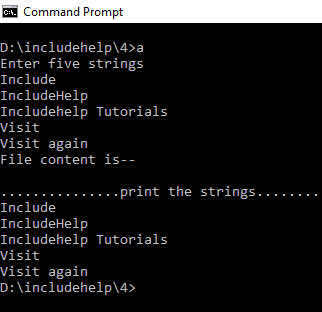C 中的 fputs() 函数
原型:
int fputs(const char *string,FILE *filename);
参数:
const char *string,FILE *filename
返回类型:整型
函数的使用:
在文件处理中,我们通过 fputs() 函数从用户那里获取字符串并将其存储到输入流中,并递增文件指针指示符以接受下一个字符串输入。函数 fputs() 的原型为:int fputs(const char *string,FILE *filename);
它在成功时返回负值并返回EOF对于失败。这里string是字符数组和filename是文件流的名称。
C 中的 fputs() 示例
#include <stdio.h>
#include <stdlib.h>
int main()
{
//Initialize the file pointer
FILE* f;
//Take a array of characters
char ch[100];
//Create the file for write operation
f = fopen("includehelp.txt", "w");
printf("Enter five strings\n");
for (int i = 0; i < 4; i++) {
//take the strings from the users
scanf("%[^\n]", &ch);
//write back to the file
fputs(ch, f);
//every time take a new line for the new entry string
//except for last entry.Otherwise print the last line twice
fputs("\n", f);
//clear the stdin stream buffer
fflush(stdin);
}
//take the strings from the users
scanf("%[^\n]", &ch);
fputs(ch, f);
//close the file after write operation is over
fclose(f);
//open a file
f = fopen("includehelp.txt", "r");
printf("\n...............print the strings..............\n");
while (!feof(f)) {
//takes the first 100 character in the character array
fgets(ch, 100, f);
//and print the strings
printf("%s", ch);
}
//close the file
fclose(f);
return 0;
}输出

相关用法
- C语言 fputc()用法及代码示例
- C语言 fprintf()用法及代码示例
- C语言 fread()用法及代码示例
- C语言 feof()用法及代码示例
- C语言 fillellipse()用法及代码示例
- C语言 fgets()用法及代码示例
- C语言 freopen()用法及代码示例
- C语言 frexp()用法及代码示例
- C语言 fclose()用法及代码示例
- C语言 fseek() vs rewind()用法及代码示例
- C语言 fflush()用法及代码示例
- C语言 fgetc()用法及代码示例
- C语言 fillpoly()用法及代码示例
- C语言 ftell()用法及代码示例
- C语言 fseek()用法及代码示例
- C语言 fgets() and gets()用法及代码示例
- C语言 fscanf()用法及代码示例
- C语言 ferror()用法及代码示例
- C语言 fgetc() and fputc()用法及代码示例
- C语言 fwrite()用法及代码示例
注:本文由纯净天空筛选整理自Souvik Saha大神的英文原创作品 fputs() function in C language with Example。非经特殊声明,原始代码版权归原作者所有,本译文未经允许或授权,请勿转载或复制。
